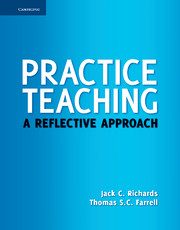Book contents
- Frontmatter
- Contents
- Introduction
- Chapter 1 Learning to Teach Through Practice Teaching
- Chapter 2 The Nature of Teacher Learning
- Chapter 3 Understanding the Teaching Context
- Chapter 4 Working With Your Cooperating Teacher
- Chapter 5 Planning Your Teaching
- Chapter 6 Teaching an Effective Language Lesson
- Chapter 7 Classroom Observation in Teaching Practice
- Chapter 8 Creating an Effective Classroom Learning Environment
- Chapter 9 Developing Learner-Centered Teaching
- Chapter 10 Classroom Discourse and Communication
- Chapter 11 Exploring Your Own Teaching
- Chapter 12 After Teaching Practice
- References
- Author Index
- Subject Index
Chapter 6 - Teaching an Effective Language Lesson
Published online by Cambridge University Press: 05 October 2012
- Frontmatter
- Contents
- Introduction
- Chapter 1 Learning to Teach Through Practice Teaching
- Chapter 2 The Nature of Teacher Learning
- Chapter 3 Understanding the Teaching Context
- Chapter 4 Working With Your Cooperating Teacher
- Chapter 5 Planning Your Teaching
- Chapter 6 Teaching an Effective Language Lesson
- Chapter 7 Classroom Observation in Teaching Practice
- Chapter 8 Creating an Effective Classroom Learning Environment
- Chapter 9 Developing Learner-Centered Teaching
- Chapter 10 Classroom Discourse and Communication
- Chapter 11 Exploring Your Own Teaching
- Chapter 12 After Teaching Practice
- References
- Author Index
- Subject Index
Summary
INTRODUCTION
Once you begin your practice teaching, an expectation that you will share with your supervisor, your cooperating teacher, and your students is that you will teach (or soon learn to teach) an effective and successful language lesson, or to put it a different way, to master the skills of good language teaching. But what does success and effectiveness in a language lesson consist of? The notion of effective teaching is a difficult one to pin down precisely because two teachers may both teach the same lesson from a textbook or teach from an identical lesson plan and teach it very differently, yet both lessons may be regarded as very effective. And are success and effectiveness the same thing? Learners may enjoy a lesson a great deal even though it fails to achieve its goals. On the other hand, a teacher may feel that he or she covered the lesson plan very effectively, yet the students did not appear to learn very much from it. And a student teacher may feel that she did a great job in teaching a difficult lesson, although the cooperating teacher felt that the lesson was not successful. As Medgyes states, “all outstanding teachers are ideal in their own ways, and as such, are different from each other” (2001: 440). And as we saw in Chapter 3, teaching is very much shaped by the context in which the teacher is working and by his or her understanding and beliefs about teaching.
- Type
- Chapter
- Information
- Practice TeachingA Reflective Approach, pp. 72 - 89Publisher: Cambridge University PressPrint publication year: 2011

